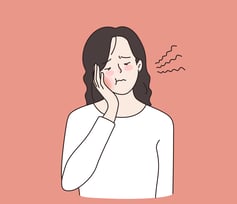
Dr. Suzie Bergman serves as a Tenured Instructor for McGann Postgraduate School of Dentistry and Progressive Orthodontic Seminars.
What is TMJ?
TMJ is an abbreviation for Temporomandibular Joint. When people say, “I have TMJ” this is similar to saying “I have knee”. We actually have two of them! The TMJ is the articulation of the movable lower jaw (mandible) and the base of the skull (temporal bone) that make it possible to open and close the mouth. Located on each side of the head, the TMJ is a ball and socket joint, with an intervening disc, that works together along with supporting jaw muscles and ligaments to allow chewing, speaking, and swallowing.
 What is TMJ Disorder?
What is TMJ Disorder?
Temporomandibular disorders are a set of diverse and multifactorial conditions that include disorders of the jaw muscles, temporomandibular joints and the nerves associated with chronic facial pain.
Researchers generally agree that the conditions fall into three main categories:
- Myofascial Pain Syndrome involves discomfort or pain in the muscles that control jaw function.
- Internal Derangement of the joint involves a displaced disc, dislocated jaw, or injury to the condyle.
- Degenerative Joint Disease refers to a group of degenerative/inflammatory joint disorders that can affect the temporomandibular joint.
A person may have one or more of these conditions at the same time.
It is important to note that the first and only long-term study of TMD (the OPPERA study), and over 30 papers summarizing its expansive findings, collectively demonstrate that TMD is a complex condition with a biopsychosocial model of illness and that it is no longer appropriate to regard TMJ disorders as a localized jaw/dental condition.
What are Symptoms of TMD?
- Pain or tenderness in the TMJ and/or jaw muscles
- Difficulty chewing or pain while chewing
- Locking of the joint, making it difficult to open or close the mouth
- Tension or pain in face or neck
- Headaches
- Pain in and around the ear
- Joint sounds such as clicking, popping or grating (Note: many people have jaw clicking without pain, and this can be a variation of normal)
What Causes TMD?
The causes of TMD remain mired in controversy.  Earlier theories emphasized dental factors of malocclusion, occlusal disharmony, and poor mandibular alignment as being primarily responsible for the development of TMD symptoms. Today, it is generally agreed that the etiology of TMD includes a multifactorial combination of physical and psychosocial factors, with some of them being either poorly understood or difficult to assess.
Earlier theories emphasized dental factors of malocclusion, occlusal disharmony, and poor mandibular alignment as being primarily responsible for the development of TMD symptoms. Today, it is generally agreed that the etiology of TMD includes a multifactorial combination of physical and psychosocial factors, with some of them being either poorly understood or difficult to assess.
Findings from OPPERA’s ongoing genetic and genomic studies have identified several disrupted biological pathways related to pain processing, inflammation, immune function, and psychological function.
What are Treatment Options for TMD?
Accurate diagnosis is essential before treatment. Most TMDs are self-limiting, so a conservative approach is best: eating softer foods, avoiding repetitive function (such as gum chewing, biting nails, ice-chip chewing), modifying pain with warm, moist heat or ice, and practicing relaxation techniques to minimize jaw tension such as meditation or breathwork.
A multidisciplinary approach is essential for more complex or chronic cases, and the various providers (e.g., dentists, physicians, physical therapists) should work as a team for better patient outcomes. When indicated, patients may require exercises to strengthen the masticatory and cervical muscles, medications (anti-inflammatories, analgesics, muscle relaxants, anti-anxiety drugs) or an occlusal guard to decrease clenching or grinding. Very rarely is a surgical intervention (such as arthroscopy or total joint replacement) required.
Read the OPPERA study here: Orofacial pain prospective evaluation and risk assessment study--the OPPERA study
If you would like more information about TMJ Awareness Month or have questions for Dr. Suzie Bergman, please feel free to email her at fivebergies@gmail.com.

